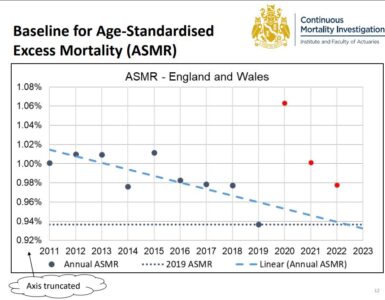The Spectator | John Roberts
https://www.spectator.co.uk/article/how-soon-will-we-see-the-benefits-of-the-vaccine-roll-out
How soon might we see the vaccine effect? With the programme in full swing, and over 2.5 million people with their first jab, the hope is that the prioritisation of the most vulnerable groups means that we will soon see a meaningful reduction in the number of cases, hospitalisations and deaths. But how soon? For some time now, my colleagues at the Covid-19 Actuaries Response Group have been looking at various figures.
We are familiar with modelling showing how Covid-19 deaths may rise if the rise of the virus were to continue unchecked. But what follows is modelling for a different scenario: how the Covid-19 figures would fall if things go broadly to plan.
As with all models, all depends on the assumptions. The following are used:-
- The vaccine is 70 per cent effective at preventing infection (as per the view of the four countries’ Chief Medical Officers).
- But that the vaccine is 100 per cent effective in preventing illness serious enough to prevent hospitalisation and death (there was only one serious illness reported across both the Pfizer and Oxford AstraZeneca trials).
- For take-up, it’s likely that the most vulnerable groups will be very keen to be protected, and similarly for those working in health and care settings. The full take-up assumed will obviously include an element of overstatement, but still indicates the potential benefit that we could see.
- That protection kicks in 14 days after the vaccine.
- It takes 3 days for a case to show up, 10 days for hospitalisation and 17 days from infection to death. With another two or three days to then show up in the figures.
- The official target – to vaccinate 14 million by mid-February – is hit.
- So by mid-Feb, the first four priority groups (accounting for 90 per cent of deaths) are covered. With protection kicking in by early March.
Given the above, how would the Covid statistics change by March?

- Covid-19 cases: a 15 per cent reduction by early March. The first four priority groups (who together make up a fifth of the population) are due to be vaccinated by mid-February: allowing for 70 per cent vaccine effectiveness, this could mean a reduction of around 15 per cent of Covid cases by early March. But more important are the implications for hospital capacity, particularly intensive care demand.
- Hospital admissions: a 60 per cent reduction by mid-March. With the burden of disease much greater on the older population, the benefits of the vaccination strategy become apparent in terms of hospital admissions, with an 60 per cent reduction envisaged by mid-March.
- Intensive care: only a third reduction. However, the impact on intensive care units is noticeably less, because the oldest and most vulnerable are less likely to be admitted to ICU (based on clinical assessment of the benefit of the treatment). So here we only expect a reduction of around one third, which is likely to leave these units very stretched.
- Covid-19 deaths: down by 88 per cent. The good news is that we expect vaccinations of these first four groups to reduce deaths by up to 88 per cent (slightly fewer in hospitals). This should all have fed through by late March, a full year from the first wave peak, although reporting in ONS data will take a little longer to emerge.
Hopefully there will be an additional benefit, with those vaccinated being less likely to transmit the virus, reducing the rate of spread. With only 20 per cent vaccinated in this first phase, and no conclusive evidence yet of reduced transmission, we’ve not modelled any benefit from such an effect.
So deaths should be much lower from April onwards. But this is, of course, just one part of Covid. We must not forget that those yet to be vaccinated will remain at risk of serious illness in the short term, as well as the unknown long-term consequences of infection. Our modelling only looks at the over-70s (Groups 1-4), as that is the government’s immediate focus. But continued vaccine rollout, at pace, is needed to get the country back to as close to normal as is possible at the earliest opportunity. With recent progress encouraging, there’s a possibility that the first milestone will not only be met but exceeded. We all must hope for that.














